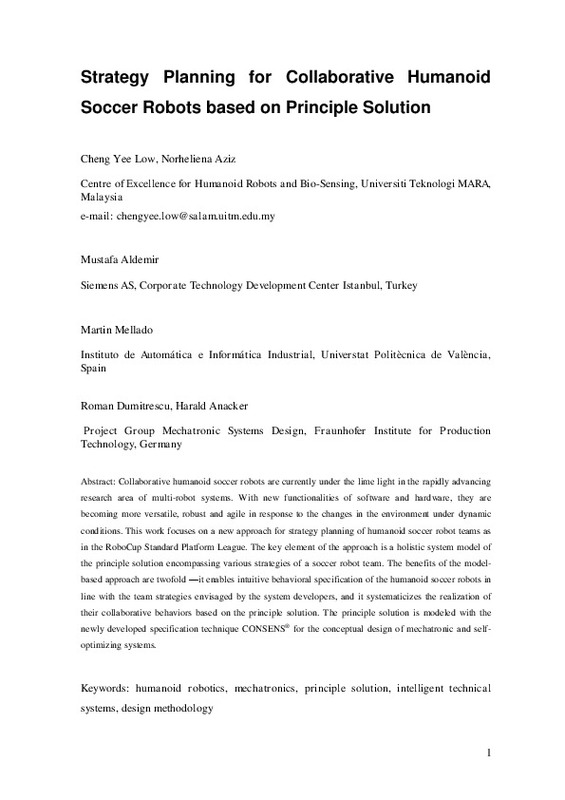JavaScript is disabled for your browser. Some features of this site may not work without it.
Buscar en RiuNet
Listar
Mi cuenta
Estadísticas
Ayuda RiuNet
Admin. UPV
Strategy planning for collaborative humanoid soccer robots based on principle solution
Mostrar el registro sencillo del ítem
Ficheros en el ítem
| dc.contributor.author | Low, Cheng Yee
|
es_ES |
| dc.contributor.author | Aziz, Norheliena
|
es_ES |
| dc.contributor.author | Aldemir, Mustafa
|
es_ES |
| dc.contributor.author | Dumitrescu, Roman
|
es_ES |
| dc.contributor.author | Anacker, Harald
|
es_ES |
| dc.contributor.author | Mellado Arteche, Martín
|
es_ES |
| dc.date.accessioned | 2014-10-21T14:53:53Z | |
| dc.date.available | 2014-10-21T14:53:53Z | |
| dc.date.issued | 2013-01 | |
| dc.identifier.issn | 0944-6524 | |
| dc.identifier.uri | http://hdl.handle.net/10251/43454 | |
| dc.description | The final publication is available at Springer via http://dx.doi.org/10.1007/s11740-012-0416-4 | es_ES |
| dc.description.abstract | [EN] Collaborative humanoid soccer robots are currently under the lime light in the rapidly advancing research area of multi-robot systems. With new functionalities of software and hardware, they are becoming more versatile, robust and agile in response to the changes in the environment under dynamic conditions. This work focuses on a new approach for strategy planning of humanoid soccer robot teams as in the RoboCup Standard Platform League. The key element of the approach is a holistic system model of the principle solution encompassing various strategies of a soccer robot team. The benefits of the model-based approach are twofold¿it enables intuitive behavioral specification of the humanoid soccer robots in line with the team strategies envisaged by the system developers, and it systematizes the realization of their collaborative behaviors based on the principle solution. The principle solution is modeled with the newly developed specification technique CONSENS for the conceptual design of mechatronic and self-optimizing systems. | es_ES |
| dc.description.sponsorship | The specification technique CONSENS was developed in the course of the Collaborative Research Center 614 ‘‘Self-Optimizing Concepts and Structures in Mechanical Engineering’’ funded by the German Research Foundation (DFG) under grant number SFB 614. The first two authors are funded by the Ministry of Higher Education Malaysia under the grant number 600-RMI/ST/ FRGS 5/3/Fst (256/2010) and 600-RMI/ERGS 5/3 (23/2011). | |
| dc.language | Inglés | es_ES |
| dc.publisher | Springer Verlag (Germany) | es_ES |
| dc.relation.ispartof | Production Engineering | es_ES |
| dc.rights | Reserva de todos los derechos | es_ES |
| dc.subject | Humanoid robotics | es_ES |
| dc.subject | Mechatronics | es_ES |
| dc.subject | Principle solution | es_ES |
| dc.subject | Intelligent technical systems | es_ES |
| dc.subject | Design methodology | es_ES |
| dc.subject.classification | INGENIERIA DE SISTEMAS Y AUTOMATICA | es_ES |
| dc.title | Strategy planning for collaborative humanoid soccer robots based on principle solution | es_ES |
| dc.type | Artículo | es_ES |
| dc.identifier.doi | 10.1007/s11740-012-0416-4 | |
| dc.relation.projectID | info:eu-repo/grantAgreement/DFG//SFB 614/ | es_ES |
| dc.relation.projectID | info:eu-repo/grantAgreement/MOHE//600-RMI%2FST%2F FRGS 5%2F3%2FFst (256%2F2010)/ | es_ES |
| dc.relation.projectID | info:eu-repo/grantAgreement/MOHE//600-RMI%2FERGS 5%2F3 (23%2F2011)/ | |
| dc.rights.accessRights | Abierto | es_ES |
| dc.contributor.affiliation | Universitat Politècnica de València. Departamento de Ingeniería de Sistemas y Automática - Departament d'Enginyeria de Sistemes i Automàtica | es_ES |
| dc.description.bibliographicCitation | Low, CY.; Aziz, N.; Aldemir, M.; Dumitrescu, R.; Anacker, H.; Mellado Arteche, M. (2013). Strategy planning for collaborative humanoid soccer robots based on principle solution. Production Engineering. 7(1):23-34. https://doi.org/10.1007/s11740-012-0416-4 | es_ES |
| dc.description.accrualMethod | S | es_ES |
| dc.relation.publisherversion | http://link.springer.com/article/10.1007%2Fs11740-012-0416-4 | es_ES |
| dc.description.upvformatpinicio | 23 | es_ES |
| dc.description.upvformatpfin | 34 | es_ES |
| dc.type.version | info:eu-repo/semantics/publishedVersion | es_ES |
| dc.description.volume | 7 | es_ES |
| dc.description.issue | 1 | es_ES |
| dc.relation.senia | 261516 | |
| dc.contributor.funder | Deutsche Forschungsgemeinschaft | |
| dc.contributor.funder | Ministry of Higher Education, Malasia | |
| dc.description.references | Asada M, Kitano H (1999) The RoboCup challenge. Rob Auton Syst 29:3–12 | es_ES |
| dc.description.references | Spaan MTJ, Groen FCA (2002) Team coordination through roles, positioning and coordinated procedures. RoboCup | es_ES |
| dc.description.references | Lau N, Lopes LS, Corrente G, Nelson F (2009) Multi-robot team coordination through roles, positionings and coordinated procedures. In: 2009 IEEE/RSJ international conference on intelligent robots and systems, October 11–15, St. Louis, USA | es_ES |
| dc.description.references | Iocchi L, Nardi D, Piaggo M, Sgorbissa A (2003) Distributed coordination in heterogeneous multi-robot systems. Auton Robots 15:155–168 | es_ES |
| dc.description.references | Almeida F, Lau N, Reis LP (2010) A survey on coordination methodologies for simulated robotic soccer teams, multi-agent logics, languages, and organisations federated workshops (MALLOW 2010). Lyon, France | es_ES |
| dc.description.references | Lückel J, Hestermeyer T, Liu-Henke X (2001) Generalization of the Cascade principle in view of structured form of mechatronic systems. In: IEEE/ASME international conference on advanced intelligent mechatronics (AIM 2001), Villa Olmo, Como, Italy | es_ES |
| dc.description.references | International Council on Systems Engineering (INCOSE) (2007) Systems engineering vision 2020. Incose-TP-2004-004-02, September | es_ES |
| dc.description.references | Gausemeier J, Frank U, Donoth J, Kahl S (2009) Specification technique for the description of self-optimizing mechatronic systems. Res Eng Des 20(4):201–223 | es_ES |
| dc.description.references | Cyberbotics Ltd., Webots overview. 20 September 2012 at http://www.cyberbotics.com/overview | es_ES |
| dc.description.references | Birkhofer H (1980) Analyse und Synthese der FunktionenTechnischerProdukte. Dissertation, TechnischeUniversitätBraunschweig | es_ES |
| dc.description.references | Langlotz G (2000) Ein Beitrag zur Funktionsstrukturentwicklung Innovativer Produkte. Dissertation, Institut fuerr Rechneranwendung in Planung und Konstruktion, Universitaet Karlsruhe, Shaker-Verlag, Band 2/2000, Aachen | es_ES |
| dc.description.references | Postel J (1980) User Datagram Protocol. RFC 760, USC/Information Sciences Institute | es_ES |







![[Cerrado]](/themes/UPV/images/candado.png)

